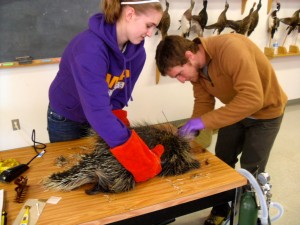Nearly a century of climate-based research has yielded important insights into the response of vertebrates to global warming. Past studies have related altitudinal and latitudinal range shifts, altered phenologies, and changes in the abundance of species to observed changes in climate. For organisms with special adaptations to winter, like the North American porcupine, climate warming will likely have strong implications on their abundance and distribution. In many cases, the mechanisms by which species persist, are locally extirpated or shift their distribution in response to changing climate remain unknown.

We are examining the effects of climate change on regulatory mechanisms for porcupines within a northern terrestrial system by 1) analyzing live-capture dataset collected from long-term (15 year) demographic study relative to both progressively moderating winter conditions, and the introduction of a previously extirpated predator, the fisher and 2) conducting fieldwork to quantify fecundity rates and juvenile survival, and relate those vital rates to behavioral and physiological responses to winter conditions and predation pressure. This project will reveal how changing climatic conditions will affect the population regulation of a winter-adapted species. Specifically, we will quantify how survival and recruitment are impacted by changing winter conditions and an expanding predator population.
This work is funded by US Department of Agriculture and the Wisconsin DNR.
